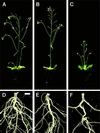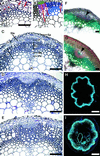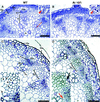The arabidopsis ATHB-8 HD-zip protein acts as a differentiation-promoting transcription factor of the vascular meristems
- PMID: 11402194
- PMCID: PMC111156
- DOI: 10.1104/pp.126.2.643
The arabidopsis ATHB-8 HD-zip protein acts as a differentiation-promoting transcription factor of the vascular meristems
Abstract
ATHB-8, -9, -14, -15, and IFL1/REV are members of a small homeodomain-leucine zipper family whose genes are characterized by expression in the vascular tissue. ATHB-8, a gene positively regulated by auxin (Baima et al., 1995), is considered an early marker of the procambial cells and of the cambium during vascular regeneration after wounding. Here, we demonstrate that although the formation of the vascular system is not affected in athb8 mutants, ectopic expression of ATHB-8 in Arabidopsis plants increased the production of xylem tissue. In particular, a careful anatomical analysis of the transgenic plants indicated that the overexpression of ATHB-8 promotes vascular cell differentiation. First, the procambial cells differentiated precociously into primary xylem. In addition, interfascicular cells also differentiated precociously into fibers. Finally, the transition to secondary growth, mainly producing xylem, was anticipated in transgenic inflorescence stems compared with controls. The stimulation of primary and secondary vascular cell differentiation resulted in complex modifications of the growth and development of the ATHB-8 transgenic plants. Taken together, these results are consistent with the hypothesis that ATHB-8 is a positive regulator of proliferation and differentiation, and participates in a positive feedback loop in which auxin signaling induces the expression of ATHB-8, which in turn positively modulates the activity of procambial and cambial cells to differentiate.
Figures







References
-
- Aloni R. Differentiation of vascular tissues. Annu Rev Plant Physiol. 1987;38:179–204.
-
- Baima S, Nobili F, Sessa G, Lucchetti S, Ruberti I, Morelli G. The expression of the ATHB-8 homeobox gene is restricted to provascular cells in Arabidopsis thaliana. Development. 1995;121:4171–4182. - PubMed
-
- Baima S, Tomassi M, Matteucci A, Altamura MM, Ruberti I, Morelli G. Role of the ATHB-8 gene in xylem formation. In: Savidge R, Barnett J, Napier R, editors. Cambium: The Biology of Wood Formation. Oxford: βIOS Scientific Publishers LTD; 2000. pp. 445–455.
Publication types
MeSH terms
Substances
LinkOut - more resources
Full Text Sources
Other Literature Sources
Molecular Biology Databases

